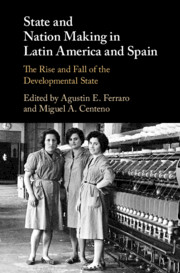Book contents
- State and Nation Making in Latin America and Spain
- State and Nation Making in Latin America and Spain
- Copyright page
- Dedication
- Contents
- Figures
- Tables
- Contributors
- Preface
- Part I Introduction
- Part II Visions and Politics of Development
- Part III Institutional Design: Infrastructural and Territorial Power
- Part IV Industry, Trade, and Growth: Economic Power
- 9 Emergence and Maturity of the Developmental State in Argentina, Brazil, and Spain, 1930–1990: an Economic History Approach
- 10 The Mexican Developmental State, c.1920–c.1980
- 11 The Developmental State and the Agricultural Machinery Industry in Argentina
- 12 The Chilean Developmental State: Political Balance, Economic Accommodation, and Technocratic Insulation, 1924–1973
- Part V National and Civic Identities: Symbolic Power
- Part VI Conclusion
- Index
- References
11 - The Developmental State and the Agricultural Machinery Industry in Argentina
from Part IV - Industry, Trade, and Growth: Economic Power
Published online by Cambridge University Press: 01 December 2018
- State and Nation Making in Latin America and Spain
- State and Nation Making in Latin America and Spain
- Copyright page
- Dedication
- Contents
- Figures
- Tables
- Contributors
- Preface
- Part I Introduction
- Part II Visions and Politics of Development
- Part III Institutional Design: Infrastructural and Territorial Power
- Part IV Industry, Trade, and Growth: Economic Power
- 9 Emergence and Maturity of the Developmental State in Argentina, Brazil, and Spain, 1930–1990: an Economic History Approach
- 10 The Mexican Developmental State, c.1920–c.1980
- 11 The Developmental State and the Agricultural Machinery Industry in Argentina
- 12 The Chilean Developmental State: Political Balance, Economic Accommodation, and Technocratic Insulation, 1924–1973
- Part V National and Civic Identities: Symbolic Power
- Part VI Conclusion
- Index
- References
- Type
- Chapter
- Information
- State and Nation Making in Latin America and SpainThe Rise and Fall of the Developmental State, pp. 266 - 283Publisher: Cambridge University PressPrint publication year: 2018



